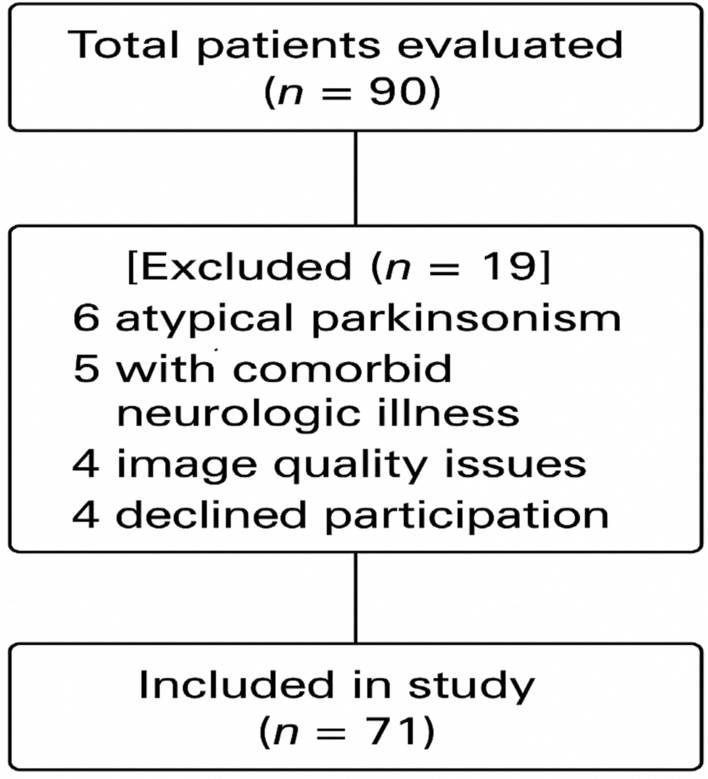- Jimmy Butler III’s 31 Points, Jonathan Kuminga’s Career-Best Shooting Fuel Warriors Win Over Lakers NBA
- Luka Doncic confesses how hard it would be for the Lakers to face Stephen Curry without LeBron James MARCA
- Why is LeBron James not playing…
Blog
-

Jimmy Butler III's 31 Points, Jonathan Kuminga's Career-Best Shooting Fuel Warriors Win Over Lakers – NBA
-
Bangladesh records over 250 dengue deaths with over 61,600 cases so far in 2025-Xinhua
DHAKA, Oct. 22 (Xinhua) — A total of 814 people were diagnosed with dengue fever in Bangladesh in the past 24 hours on Tuesday, said the Directorate General of Health Services (DGHS) under the Ministry of Health.
With the fresh infections…
Continue Reading
-

The role of proton magnetic resonance spectroscopy in idiopathic Parkinson disease | Egyptian Journal of Radiology and Nuclear Medicine
Despite growing interest in neuroimaging biomarkers for idiopathic Parkinson’s disease (IPD), a critical gap persists in identifying accessible, non-invasive tools for early diagnosis and monitoring. We aimed to establish MRS as a practical, reproducible, and clinically applicable biomarker tool in IPD diagnosis and progression tracking. Proton magnetic resonance spectroscopy (MRS) can detect neurochemical alterations in vivo, yet most studies are limited by small cohorts, single-voxel methods, or high-field MRI dependence [11]. The novelty of our study lies in its use of multi-voxel MRS on a widely available 1.5 Tesla scanner in a relatively large cohort, with targeted assessment of the substantia nigra—a region often underrepresented due to technical challenges. By correlating metabolite ratios with detailed clinical severity scales.
Regarding sociodemographic characteristics, our study demonstrated no significant differences between patients and controls concerning age (61.45 ± 9.82 vs. 64.37 ± 10.61 years; p = 0.09) or sex distribution (77.5% vs. 71.8% male; p = 0.44). This is consistent with the previous epidemiological studies that reported similar demographic distributions in Parkinson’s disease cohorts, suggesting that age and sex matching were successful in avoiding confounding effects [12]. However, we found a significantly higher proportion of patients with occupational exposure to agricultural fields compared to controls (p = 0.001), supporting the hypothesis that environmental toxins may contribute to disease risk. This aligns with the findings of another study, which emphasized environmental and lifestyle influences on Parkinson’s disease, especially in rural populations. Thus, our study adds further evidence that environmental exposure should be considered in disease risk assessment, particularly in resource-limited regions [13].
Regarding radiological findings, our study revealed significant neurometabolic alterations in IPD patients compared to controls, with decreased NAA/Cr and NAA/Cho ratios and elevated Cho/Cr ratios across the caudate, lentiform nuclei, and substantia nigra. These findings are consistent with earlier reports that MRS can differentiate Parkinson’s patients from healthy individuals [13, 14]. For example, Shoeibi et al. [15] demonstrated similar metabolic alterations, particularly reduced NAA/Cr in the substantia nigra, reinforcing the value of spectroscopy as a biomarker of neuronal loss.
Additionally, Lucetti et al. [16] demonstrated cortical NAA/Cr reduction in newly diagnosed patients, which supports the notion that metabolic alterations occur early in disease, though they localized changes outside the basal ganglia due to technical artifacts. Taken together, our results confirm the reproducibility of MRS findings in IPD, while highlighting that methodological differences across studies can influence observed regional patterns.
Our findings also align with Amartumur et al. [3] and Das and Ramteke [4], who emphasized the role of metabolic stress, mitochondrial dysfunction, and neurodegeneration in IPD pathophysiology, processes that MRS captures indirectly through metabolite shifts. However, Marino et al. [17] reported no significant differences in NAA/Cr or NAA/Cho between IPD patients and controls in the lentiform nucleus, findings that contradict ours. This discrepancy may stem from their smaller sample size, differences in voxel placement, or technical limitations of 1.5 T acquisition. By contrast, our relatively larger cohort and multi-voxel approach provided stronger statistical power to detect subtle metabolic changes, particularly in the substantia nigra.
Regarding correlation with disease severity, in our study, NAA/Cr and NAA/Cho ratios correlated negatively and strongly with UPDRS scores and Hoehn and Yahr stage, while Cho/Cr ratios correlated positively with disease severity. For instance, left substantia nigra NAA/Cho showed a strong negative correlation (r = –0.823, p < 0.001), confirming that metabolite alterations mirror clinical disability. This is consistent with the previous findings. Marino et al. [17] observed negative correlations between NAA/Cr and UPDRS, although their results did not reach significance in smaller subgroups, emphasizing the need for larger cohorts such as ours.
Similarly, Cao et al. [18] also reported diminished substantia nigra NAA/Cr levels in drug-withdrawn PD patients, supporting its role as a progression marker. Our results diverge from some earlier reports. Another study found no differences in basal ganglia metabolite ratios in IPD, suggesting that MRS was more sensitive to atypical Parkinsonism (MSA, PSP). However, their patient numbers were limited and lacked detailed correlation with UPDRS subscales. By contrast, our study’s novelty lies in comprehensive correlation across all UPDRS domains, providing robust evidence that metabolite changes not only distinguish patients from controls but also quantify disease burden. Mazuel et al. [19] further showed that acute levodopa administration could modulate putaminal metabolites, suggesting that treatment status is a confounding factor, which we partially addressed but could not fully eliminate, given that only one of our patients was drug-naïve.
Regarding correlation with disease duration, most radiological markers in our study showed weak or no correlation with disease duration, except for right substantia nigra NAA/Cho, which correlated negatively (r = –0.304, p = 0.010). This suggests that metabolite decline may occur selectively in specific regions over time, independent of clinical staging. Similar results were reported by another study, which observed that while cross-sectional metabolite differences were limited, correlations with disease severity emerged in patients with longer disease duration. In contrast, Clarke and Lowry [14] emphasized that metabolite reduction was more apparent in atypical Parkinsonian syndromes, highlighting the complexity of disease progression markers. Our findings thus support the hypothesis that MRS can capture region-specific neurodegeneration over time, although longitudinal follow-up is required to confirm progressive metabolic decline.
This study presents several notable strengths. First, the sample size is relatively robust for MRS-based research in Parkinson’s disease, including 71 well-characterized IPD patients and an equally matched control group. Second, the study employed a multi-voxel magnetic resonance spectroscopy approach, allowing for comprehensive metabolic assessment across key subcortical regions, including the substantia nigra, which is often underrepresented in spectroscopy due to technical challenges. Third, the inclusion of detailed clinical correlation using the full Unified Parkinson’s Disease Rating Scale and Hoehn and Yahr scales adds depth to the interpretation of magnetic resonance spectroscopy findings. Finally, the study was conducted using a 1.5 Tesla magnetic resonance imaging scanner—a modality widely available in clinical practice—thereby enhancing the external validity and real-world applicability of the results.
Despite its contributions, this study has several limitations that should be acknowledged. One significant limitation is the use of a 1.5 T magnetic resonance imaging scanner, which offers lower spectral resolution compared to 3 T or 7 T systems, possibly limiting the accuracy of metabolite quantification. Additionally, the majority of participants were already receiving dopaminergic therapy, and only one patient was drug-naïve, which introduces the potential for medication-induced alterations in metabolite levels. Furthermore, the cross-sectional design of the study limits the ability to assess causality or monitor changes over time. The study population was also geographically limited, with a predominance of rural patients, which may impact generalizability. Finally, the study did not evaluate longitudinal clinical outcomes or therapeutic responses, which would be essential for establishing the prognostic value of magnetic resonance spectroscopy biomarkers.
Continue Reading
-

Apple may soon get a new CEO and iPhone users may finally be able to… (HT Tech)
Apple CEO Tim Cook is turning 65 on November 1, sparking rumours of retirement. There are reports and talks about who will be the potential candidate to take place as Apple’s new CEO, and who will replace the long-time reign. While there is…
Continue Reading
-

Mission to Mars — Bad science fiction
This is an audio transcript of the Tech Tonic podcast episode: ‘Mission to Mars: Bad science fiction’
Kim Stanley Robinson
Mars was empty before we came. That’s not to say that nothing had ever happened. The planet had accreted, melted,…Continue Reading
-
The request could not be satisfied
ERROR: The request could not be satisfied
The request could not be satisfied.
Request blocked.
We can’t connect to the server for this app or website at this time. There might be too much traffic or a configuration error. Try again later, or…Continue Reading
-

What Comes After the ‘Clean Girl’?
The UK makeup artist and content creator Mikai McDermott thinks we will see the “clean girl” forever. While she experiments with more maximalist touches like a full strip lash, or a daub of glittery eyeliner, she still favours a glassy-like…
Continue Reading
-

Assessing the in vivo safety of dendrimer-based formulations used in p
Introduction
Photodynamic therapy emerged as a treatment option more than 50 years ago. The results of research by Diamond et al, published in the Lancet in 1972, showed that photodynamic therapy could be an effective approach to the treatment…
Continue Reading
-

Being a Girl*!? – Announcements
Being a Girl*!? is a multimedia exhibition that explores how images of girl*hood have evolved across time and culture. It brings together over 150 works by international artists who investigate what motivates girls* today and how inherited role…
Continue Reading
-

Platform launch: when art and illness speak the same language – Announcements
Proyect.IN—when art and illness speak the same language. On Wednesday October 22, 2025, at the Museo Nacional Thyssen-Bornemisza in Madrid a new artistic platform is emerging from silence.
Proyect.IN was born from the conviction that art is…
Continue Reading